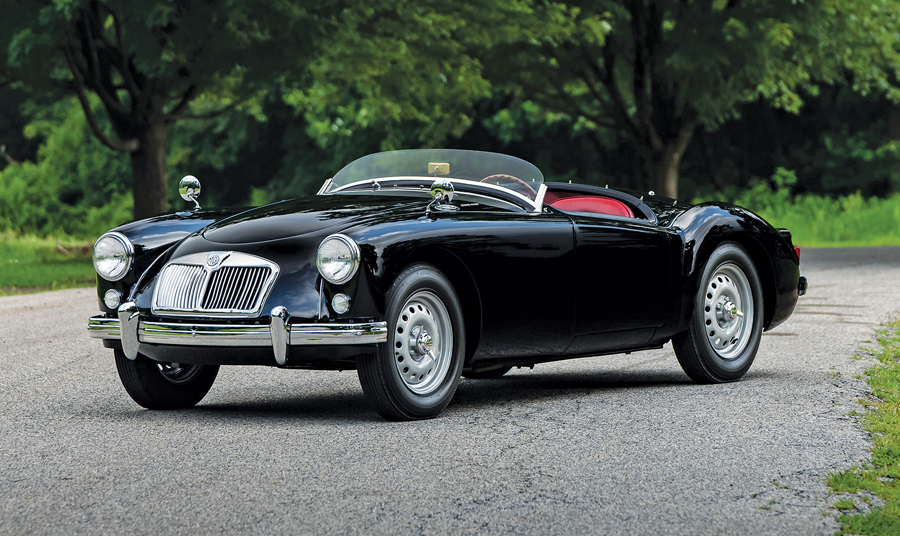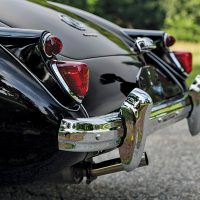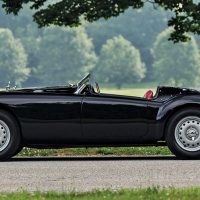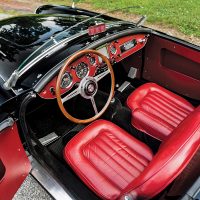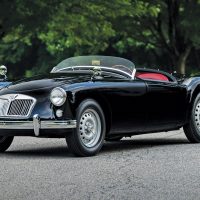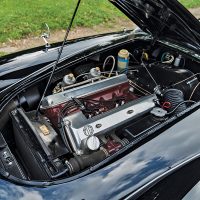- Multiple AACA Award winner
- Original engine and colors per BMIHT Certificate
- Fitted with competition accessories from the factory
- Original and properly installed optional Radiomobile radio
- Restored to the highest standards of correctness and quality
SCM Analysis
Detailing
| Vehicle: | 1960 MGA Twin Cam Roadster |
| Years Produced: | 1958–60 |
| Number Produced: | 2,111 |
| Original List Price: | $3,345 |
| SCM Valuation: | $51,500 |
| Tune Up Cost: | $500 |
| Distributor Caps: | $50 |
| Chassis Number Location: | Stamped tag screwed to shelf at rear of engine compartment |
| Engine Number Location: | Embossed plate screwed to ledge on engine next to spark plugs |
| Club Info: | North American MGA Register, MG Vintage Racers |
| Website: | http://www.namgar.com |
| Alternatives: | 1955–56 Austin-Healey 100M, 1956–59 Porsche 356 roadster, 1958–62 Alfa Romeo Spider Veloce |
| Investment Grade: | A |
This car, Lot 3185, sold for $65,725, including buyer’s premium, at RM Auctions’ Auburn, IN, sale held August 29 to September 1, 2019.
The sale result on this car immediately begs two questions: Why did this particular model of MGA fetch a price well in excess of most MGAs, and — given the rapid recent growth in prices of similarly rare Austin-Healeys and Jaguars — why didn’t it sell for considerably more?
The answer to the first question is implicit in the model’s history. The MGA that finally made its way to production was born in racing. In 1951, George Phillips took the boxy, high-fendered MG TD and gave it a sleek body to race as a special at Le Mans.
But with attention focused on other opportunities such as the new Austin-Healey, BMC shelved the idea. It wasn’t until Sydney Enever designed a sturdy new frame under the sleek, aerodynamic body style — a design that allowed the occupants to sit below the frame rails — that the MGA got a green light. It debuted in September 1955, to replace the long-in-the-tooth MG TF.
A driver’s MG
Anyone who has driven an MGA in vintage racing will tell you that that combination of rigid frame, low center of gravity and independent coil-spring wishbone front suspension with live rear axle has great handling. It is just plain fun to drive, able to stay precisely on course or go into a controlled drift with just the slightest flick of the very direct steering. The easy-shifting 4-speed transmission provides accurate rev control in all circumstances.
The model sold 13,000 units in its first production year. Unfortunately, that basic 1,489-cc B-Series engine that had first appeared in the ZA Magnette, taking well into the teens to reach 60 mph and topping out at 95 mph, could be beaten in a straight line by almost every other sports car. If that weren’t enough, then the Austin-Healey got a 6-cylinder engine and Triumph cleaned up its styling act with the TR3. The MGA was pushed back into the shadows.
More cams, more power
BMC engineer Gerald Palmer at Cowley came up with an answer in 1958: Put a twin-camshaft head on the B-Series block and, boom, 108 horsepower, 110 mph and 10.4 seconds 0–60. Accentuating the power gain, the Twin Cam came standard with competition Dunlop disc brakes and center-lock racing wheels on all four corners.
Unfortunately, what looked great on paper didn’t do as well on the street. Selling at a premium over the standard 1,600-cc MGA, and pricier than the now-2+2 Austin-Healey, the car didn’t sell nearly as well as had been hoped. Even worse, customers started showing up at their dealers with their Twin Cams on the hook, having overheated and often blowing their engines.
The warranty costs on these failures were so significant that BMC had to do something. The problem seemed to be that when the carburetors weren’t tuned properly, they were feeding different fuel mixtures to the front and rear cylinders. BMC even went so far as to fit out special buses with small classrooms and training facilities and send them out on the road to train local dealer staffs. (There are at least two of these buses, restored in their Union Jack colors, that appear on the auction circuit every now and then.)
But it wasn’t enough. With losses mounting and a 1,622-cc version of the basic pushrod engine ready for production, the company discontinued the Twin Cam after only 2,111 units had been produced. The basic competition parts — Competition Suspension with four-wheel disc brakes and center-lock racing wheels, and Competition Deluxe seats — remained on the options list. Today, that model, nicknamed the MGA Deluxe, is a recognized variant in the collectible marketplace.
Making the Twin Cam work
Meantime, amateur racers who were wedded to the MG Octagon did snap up the cars — including broken ones sitting on the back of the dealer lots — and were reasonably successful with them. The difference was that carburetors, timing and fuel mixture were checked with every race. That seemed to make the difference.
Today’s vintage racers wearing the octagon on their racing suits, with the assistance of tuning dynos, have solved the problem of twin-cam engine failure. It turns out that at high rpm, the carburetors start to vibrate with the engine, and the float on the rear carburetor hangs up on its spindle. This leans out the mixture, in short order causing the engine to overheat, often resulting in a hole in the number-three or -four piston. The simple expedients of balancing the engine and flexibly mounting the carburetors with rubber O-rings layered with the gaskets have made the few remaining engines almost bulletproof.
Rare and desirable
So the combination of being the fastest stock MGA available on the market, being quite rare, available only in documented low numbers, and being inexpensive relative to similarly rare competitors has made Twinks, as they’re now affectionately referred to, desirable enough to fetch the high prices.
Why didn’t this car sell for more? While this example at Auburn sold for only a bit more than a similar example SCM profiled seven years ago, another Twink broke the $100,000 barrier in Monterey this year, suggesting some pricing movement over the current $51k median. The simplest answer for this car lies in its nicely restored condition being offset by a slightly modified configuration.
The new owner of this black beauty did fine here, and after locating a stock windshield, soft top and side screens to put on for touring in the rain, will most likely be out on some high-zoot tours soon. He or she might even be lording it over more-expensive Italian cars sitting on the side of the road, waiting for a six-carburetor tuning specialist named Guido.
(Introductory description courtesy of RM Auctions.) ♦
